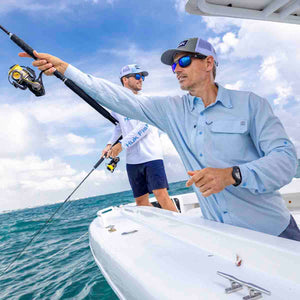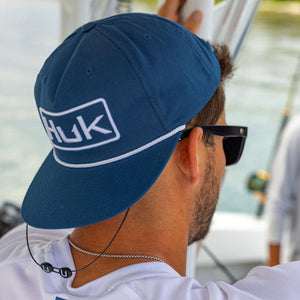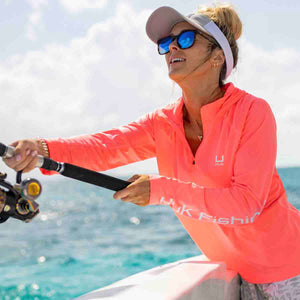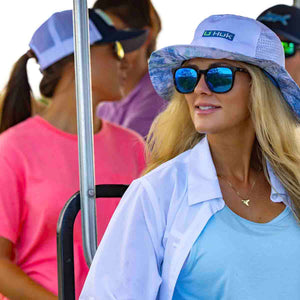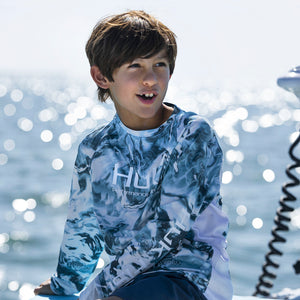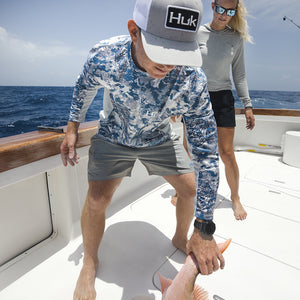From their ornery disposition to punishing ability to wear down an angler, blue marlin enjoy a legendary status around the world. Commemorated most famously as the stubborn antagonist in Ernest Hemingway’s The Old Man and the Sea. No doubt, when chasing after “The Man in the Blue Suit”, you definitely need to up your game to even stand a chance. Tackle preparation, reading the water, proper baits and rigs and finally, battle technique all need to be running on full cylinders to make it a successful venture.
THE GROUNDS
Both Atlantic blue marlin and Pacific blue marlin are tropical in nature, and will follow water temperatures that suit them best, generally somewhere in the 70 to 85-degree range. As pelagic creatures, blue marlin are found around the world’s oceans and tend to gravitate to the deep dropping edges of underwater canyons along the continental shelf, hanging by submarine seamounts and around any island that harbors steep drop-offs along their coast. Hot spots around the world include Hawaii, Gulf of Mexico, Australia, Caribbean islands, North Carolina and the Azores, but blues can be found roaming the open ocean as well on their pelagic journeys. BIG TIME GEAR
BIG TIME GEAR
You know all those huge rods and reels you see hung on the walls of salty coastal bars that look like they can’t possibly be real due to their size? Well, that’s the gear you use to battle blues. Old “knucklebuster” direct drive reels are a thing of the past and now smooth lever drag 80 to 130 class reels such as Penn Internationals or Shimano Tiagras are matched with heavy action bent-butt or stand-up rods rated for 80-plus pounds, like the Penn International Tuna Stick or Shimano Tallus series rods. Reels are generally spooled with 80 to 130-pound monofilament line, tied off with a Bimini Twist, then an offshore knot to a 300 to 900-pound ball bearing swivel. From the swivel is attached a long 30-foot crimped 300 to 500-pound mono leader fixed with a trolling lure like a chugger, daisy chain, bird or jet which is crimped to the leader and attached with 400 to 600-pound cable, attached with a large 10/0 to 12/0 J-Hook. Rigs vary greatly between captains, it all depends on what set up you are comfortable with. LURES AND BAITS
LURES AND BAITS
Depending on availability of marlin and frequency of the bite, offshore marlin anglers will troll either lures, baits or a combination of both. A wide variety of chuggers, jets, plungers, and birds are available, made by Mold Craft, Ilander, Joe Yee, Black Bart and other offshore-specific tackle manufacturers. What lures you pick all depends on preference of color selection and design, though usual hot color combos include blue/white, green/yellow, pink/blue and black/purple. Live baits like false albacore and bonito are kept alive in tube livewells and can be bridled through the nostrils via rigging needle and thread to a size 14/0 circle hook. Dead baits such as ballyhoo can be wired naked with a chin-weighted wire ballyhoo rig, or wired with a Joe Yee or Ilander skirt for added attraction.
SET THE SPREAD AND SPEED
Marlin trolling means putting out a spread that involves rigger baits, flatlines and freeline baits. Larger lures like chuggers and plungers can be sent out on the outriggers off each side, while live baits can be sent back from flatlines off the stern. Trolling speed is generally in the 8 to 10 knot range, adjusting the throttles dependent on current, wind, and tide. A general “W” trolling pattern is a good spread to start out with, keeping the lures riding on the downsides of your first, second and third boat wakes. Look to target areas of “bluewater”, which is nutrient rich seawater that appears electric blue or purple in color. Usually bluewater is found off spinning offshore eddies or around submarine seamounts where conditions of upwelling occur as underwater currents push up against the seamount and bring nutrients, plankton and baitfish up to the surface. BATTLING THE BLUE
BATTLING THE BLUE
After a big blue is hooked, it’s game on. Sometimes, the battle can last hours—so being physically capable is definitely worth consideration. Smaller marlin of 100 to 200 pounds can be battled with a stand-up belt, but larger blues over 300 pounds sometimes require an angler to sit in the fighting chair. The key to gaining line on a wild blue is to pump and reel in short, quick strokes of the rod, by sliding back in the seat raising the rod tip to a 60-degree angle, then reeling down to put line back on the reel. Repeat that process gaining 5 feet of line at a time. When the fish runs and jumps, let it do its thing, don’t try to reel when it runs—you’re just wasting energy. Slow and steady wins the race. Once the billfish gets worn out, if everything works in your favor, you’ll have him boatside where the mate will wire the fish to control it, then dislodge the hook from the marlin’s mouth.
My first blue marlin was released while trolling Joe Yee lures off the British Virgin Island of Virgin Gorda and I’ll never forget the rush witnessing a 300-pound gladiator all lit up thrashing about, brought to boatside, then released quickly to swim freely again. Play your cards right and you be able to check a blue off your billfish list. Oh, and there’s one other point to note regarding the catch—once you land your first blue, be prepared for “the dunk”: the accepted celebratory rite of passage of getting thrown off the boat into the ocean. Sorry, it’s mandatory!
- NICK HONACHEFSKY
